Steven Lewis's Blog, page 18
October 10, 2016
Are you missing this basic chance to promote your small business?
 When you sell a service like reviewing a website, you are the product. Hence this beautiful picture of me.
When you sell a service like reviewing a website, you are the product. Hence this beautiful picture of me.So many small businesses are making this basic mistake. Are you one of them?
Being immersed in reviewing so many different websites over the last month has given us new insights into common mistakes small businesses are making. Fixing these mistakes would turn more website visitors into customers.
Are you forgetting to show your product?
One oversight we’ve noticed is common with small businesses is that they forget to show the product. That means they waste precious opportunities to get website visitors over the line.
Can you imagine there’s a page on the Hyatt’s website that doesn’t have a picture of a hotel, a spa, a golf course or some other aspect of their product?
But we see many small businesses that either don’t show the product at all or show it far too little.
If you offer a service, the product is you
If you’re an MC, a business coach or a wedding celebrant, the product is you. You should be pictured on every page to let people see the quality of what they’re buying. (Preferably these will be shots of you with people enjoying your work.)
If you’re an architect or a lawyer, you might not want a picture of yourself on every page — a bit egotistical even for a lawyer — but you should at least have a picture that represents your work.
Stock pictures are not the answer
You might have to get creative about how you do that. By creative, we don’t mean using a stock image. Stock images can’t show the product you’re trying to get your website visitor excited about buying. (Would you be excited about going to a restaurant that used stock images of food on its website?)
Every. Single. Page.
And we do mean every page should have a picture of the product.
Why, for instance, wouldn’t you have pictures on your contact us page? If you’ve got the visitor to your contact page, you’ve got them interested. It’s not the time to throttle back on persuasion.
If every single page of your website isn’t affirming and selling the quality of your product, you’re missing a trick.
Get your website professionally reviewed
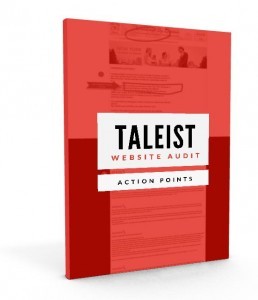 Your website review comes with more than 20 pages of actionable tips and insights from our professional analysis of your site
Your website review comes with more than 20 pages of actionable tips and insights from our professional analysis of your siteWhat’s every lost lead costing you? What if some simple advice could turn more of those leads into customers? If you’re interested in getting our advice tailored to your website, check out our website reviews.
Your comments were very helpful. Greatly recommend you. Thanks! — Anna Wong, Ashburton, Victoria
The post Are you missing this basic chance to promote your small business? appeared first on Taleist.
September 14, 2016
Why you should never write a first draft
 It’s not goofing off if you’re writing
It’s not goofing off if you’re writingYesterday, I had a coffee meeting with a prospective client. Before the meeting, he’d sent me a brochure he’d drafted for a new product.
The brochure was fine. The writing progressed logically; it told me exactly what I’d get with the product, and it was all grammatically correct. But it was fatally flawed. You’d have bought what he was selling only if you were already convinced that this was something you wanted and that he was the guy to sell it to you.
The amazing thing was that he fixed that fatal flaw from the moment he sat down in the cafe. He just didn’t realise he was doing it.
Over coffee, he told me why he cared about what he was selling, how far he’d travelled to find the right product, and how many other products he had tested and rejected as not just right for his clients.
In the end, he’d spent tens of thousands of dollars on finding the right thing (and saving his clients from products that looked good but wouldn’t deliver).
He gave me examples of people who’d been helped by what he was selling.
It was extremely convincing.
So why, I asked him, was none of that in his draft brochure.
Over coffee, he had effortlessly convinced me about what he was selling and his credentials to be selling it. But when it had come to writing it down, he had reflexively started to be “serious”.
The great story of the question that had needled him into traveling to three continents looking for an answer had not made it anywhere into the brochure. Even the stories of the people who’d benefited as a result were nowhere to be found.
Why the story is everything
Those stories probably seemed flimsy next to all the concrete detail he now had about what he was offering. But the stories were far more powerful than the features of the product because they held the answers to the most important questions anyone would ask before buying from him:
Why you? Because I care about this so deeply that I spent years tracking down the right answer and rejecting alternatives that look good but ultimately disappoint.
How will I benefit? I could list for you all the “things” that you’ll get, but let me show you the difference these products have made to him and her and her and him and that guy.
Years of school teach us that the Devil is in the detail, but detail is often the Devil when it comes to persuasion. We make our decisions based on emotion, whether we like to believe it or not. The research is in and it’s conclusive, whatever your English teacher told you.
So next time you’re sitting down to write something persuasive stop and do nothing until you talk it over with a friend over coffee.
 We’re generally better at interesting our friends over coffee than we are at convincing strangers in writing
We’re generally better at interesting our friends over coffee than we are at convincing strangers in writingHow to write copy over coffee
Your first draft shouldn’t be in writing because it should be that conversation.
Be natural but notice:
Where do you instinctively start? Trust your gut. Do you start by describing how finely your new pepper mill grinds pepper or do you start by talking about how fantastic food tastes with finely ground pepper? Where you start in conversation with a friend is probably the most interesting part–we want to fascinate our friends–so that’s where your writing needs to start.
What stories do you tell to illustrate your points? Every time I asked my prospective client a question about some aspect of what he was selling, he answered me with a story. “Well, I found the answer to that when I visited this guy in Malaysia…” But there was not a single story in his brochure. The more he told me of his story in coming up with his product, the more I was convinced he was a guy to trust when he said he had the right answer.
Free persuasive copywriting course
Following the chat-over-coffee approach will help you naturally hit many of the points we teach in our free persuasive writing course. If you haven’t checked it out already, you’ll find it here.
The post Why you should never write a first draft appeared first on Taleist.
August 21, 2016
Why hardly any customers see what you put on Facebook
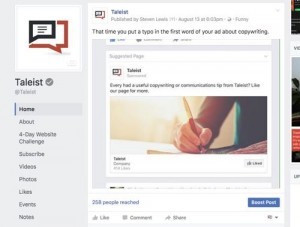 258 people saw this post. If I hit “boost”, I can pay to reach more.
258 people saw this post. If I hit “boost”, I can pay to reach more.Dale Jacobson, a subscriber to our mailing list and a graduate of our Build Your Brand on Twitter course, emailed me to ask why her Facebook posts aren’t being seen by fans of her page.
Dale works hard on her Facebook page, Why Antarctica? She posts almost daily. But even though Facebook knows 200 people “like” her page, it often reports to her that a post has only reached five or so people.
What “reach” really means on Facebook
If I told you there were four fewer bottles of wine in my cupboard this morning, it would be just as true but not as accurate as saying, “We had a big one last night”.
When Facebook says “your post only reached five people” it’s really saying, “We decided we’d only show your post to five people. So there.
The greatest bait and switch in advertising history
Remember when billboards for youth-orientated brands started to display Facebook URLs instead of website URLs? Facebook.com/Coke instead of CocaCola.com. The web was like so dead. Eventually, even the most fuddy-duddy players hipped themselves to the Facebook thing.
 “Hello, my beautiful customers.”
“Hello, my beautiful customers.”These companies spent a fortune building an audience for their Facebook page. Smaller companies might not have had billboard dollars but they sweated expensive time into building a following.
Businesses large and small were falling over themselves to help Facebook increase its market value. And Facebook graciously let them.
Oceans of money that could have gone into driving traffic to corporate websites were drained sending people to Facebook pages instead.
It was exhilarating to marketers. When you liked them on Facebook they could not only count you but they could see your pretty faces. They knew who you were, how old you were, where you were. They were so intoxicated by your presence on their Facebook page that they forgot they couldn’t contact you without Facebook’s help.
Facebook drops the hammer on that communication
Then marketers noticed their “reach” started to fall off a cliff.
Once upon a time a post to a Facebook page might have reached 20% or more of the fans of that page. Reach depended on how engaged people were with the page. (Once Facebook detects your interest in a page has waned, it shows you less from that page.)
But 20% wasn’t bad. Many email marketers would be cockahoop with an open rate of 20% for their emails.
Today, you can expect Facebook to show a post to about 6% of your fans.
Why did Facebook throttle the reach of posts?
Why the bait and switch? Because Facebook doesn’t make money showing people posts for free. It makes money when you pay to “boost” a post.
That’s right, Facebook sat back rubbing its hands while marketers built audiences they could only reach by the grace of Facebook. Then it held out its palm to be crossed with silver.
Basically, Facebook told Dale that if she wants to reach more than five or so of her 200 fans, she’s going to have to pay to do it.
What can we learn from Facebook’s bait and switch?
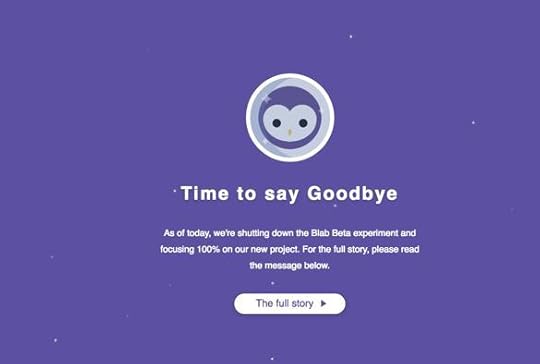 Here today, gone tomorrow. Blab grew to 3.9 million users in its first year. Then one day they visited the site to find this. Hopefully none of those users invested too much in building their Blab presence.
Here today, gone tomorrow. Blab grew to 3.9 million users in its first year. Then one day they visited the site to find this. Hopefully none of those users invested too much in building their Blab presence.1. Be wary of building on someone else’s land
You don’t own your Facebook page or your Facebook audience. Mark Zuckerberg does.
 If you have a Facebook page, you don’t own it. Mark Zuckerberg does.
If you have a Facebook page, you don’t own it. Mark Zuckerberg does.The same is true on every social network — Twitter, Pinterest, LinkedIn… The rules can change anytime. If you’ve got half an hour, buy me a beer and I’ll talk to you about all the times people have been caught since I started working in social media in 2005.
It’s not just social media where people get caught out. At the moment, I’m tracking people who sell online courses on sites like Udemy then scream blue murder when the site changes its commission structure and other rules.
A few months ago Udemy told all instructors their courses could be priced only between $20 and $50. Imagine hearing that when you’ve spent months creating a course you were selling for $500? Then, by the way, it decided last week that this had been a boo boo and that the ceiling price was going up to $200. Whoops!
That isn’t to say there isn’t a place for building a following in social media or building something on someone else’s land. It’s an argument for making sure your cost/benefit analysis takes into account that you could lose everything you’ve put into the social network without notice. Or things could get more expensive very quickly.
2. Your Facebook page or other social media presence should never ever be the hub
It’s boringly true that social media is important to growing your reputation. You don’t need me to give you half a dozen examples of people who owe their livelihood to people finding them through social media. Justin Bieber might’ve been discovered on YouTube but he doesn’t rely on it today as his primary way to communicate with his fans.
Your website should be the hub of your online presence. A significant portion of your social media effort should be devoted to getting people to visit your website and join your mailing list. Because it’s all yours. No one can take away from you, no one can change the rules, no one can charge you for communicating with people who have given you their contact details.
Your presence in social media is a spoke coming off that hub. That way if you lose a spoke you don’t lose the whole system. Don’t be the guy who put all his eggs in MySpace or Google plus. Build your own intellectual property asset and use marks are good works as you see fit, just remember he’s using you to.
Isn’t it ironic?
This page is adorned with social sharing buttons and I’d be hugely grateful if you’d use one (or even more) of them to help get the word out about this site. Let’s beat Facebook at its own game and help a business grow without having to pay Facebook!
The post Why hardly any customers see what you put on Facebook appeared first on Taleist.
August 6, 2016
Should you put your prices on your website?
“Should I put my prices on my website?” I get asked it all the time. It’s not a yes/no question in a services business. It depends on your industry, your competitors and your business goals. Here are some things you need to think about to help you decide whether you should put prices on your site or not.
So should you put your prices on your website…
Is your price within the range charged by competitors?
If your price is more (or less) than your competitors, you need to communicate why, which might be better done in person. And if it’s much more expensive, you definitely need a website that supports that. You’re not going to sell an Armani jacket on a website that makes you look like Kmart. (Did you know we review websites?)
Is everyone else doing it?
If everyone else has their prices on their website, you could lose out if you don’t. If someone cruises a few websites harvesting pricing information from enough competitors, they’re probably not going to jump through some extra hoops to get that information from. They’ll take the negotiation to the next stage with your competitors.
If someone cruises a few websites harvesting pricing information from enough competitors, they’re probably not going to jump through some extra hoops to get that information from. They’ll take the negotiation to the next stage with your competitors.
Need some Google love?
Could you do with more visitors finding you through Google?
We offer business book ghostwriting. That’s something people search for, but they also search terms like “how much is a ghostwriter?” By putting indicative fees online, we become an answer to that question. We know Google sends us potential customers that it doesn’t send our competitors because those competitors don’t have any ghostwriting fees information online.
How do you feel about tyre kickers?
Maybe you do charge a premium and you’re sick of wasting time on people who won’t pay what you’re worth, so you might as well filter them out. If you charge more than the average bear and you’re worth it, you don’t need to waste time talking to people who don’t have that kind of money or any interest in paying it.
Not so fast, though. The other side of that is that you might have potential customers who don’t think they want to pay your fee but that’s only because they don’t know how worth it you are. They don’t understand how much value they’d be getting.Not putting your
Not publishing your fee so people have to make contact means you have a chance to sell them the value.
What’s it worth?
If pricing information in your industry is scarce, people might be willing to “pay” for it by giving you their email address. Once you have their email address, you can follow up–Did you find that helpful? Here are 7 tips for…
That follow-up doesn’t even have to be manual. You can put them into a marketing automation sequence. Mailchimp will do that for you for free with a simple autoresponder.
Want more like this?
Join our mailing list for tips, tricks, videos, discounts and free webinars.
Should you put your prices on your website? from Taleist – Using storytelling and journalism to help companies stand out
Transcript
Steven Lewis:
Should you put your price on your website? It’s a great question. It’s one that applies mostly to services businesses. In product businesses you would probably expect to see a price on a website. When it comes to services, there’s a lot of debate as to whether you should put a price on the website, or not. There are a number of things you need to consider.
Firstly, is your price comparable to your competitors? Somebody who arrives on your website and sees your price, might well have spoken to, or seen the websites of other people in your industry. If you’re a lot cheaper, or a lot more expensive, that’s something you’re going to have to explain, and it’s something that your website is going to have to support.
If you’re more expensive than your competitors, then your website has to look higher quality and more premium than your competitors. Your copy has to explain that away.
If that’s something that you’re worried that your website doesn’t do, or you can’t do in the copyrighting, you maybe be better of holding back and waiting, until you have an opportunity to talk to somebody, so that they can get a feel for you, and you can talk to them about why your price is different from your competitors.
The second thing to look at is, of course, whether all of your competitors are listing their prices on their website. If they are, and you don’t, that could knock you out of the running. When somebody goes online to do their research, they find a few people in your industry.
They look at the prices. They come to your website. You don’t have your price on. Maybe they’re not even going to bother to call or email you, unless they’re so impressed by your website, or they’ve been referred to you, or they’ve had some other sort of recommendation of you. You could knock yourself out of consideration, if you’re not providing the information that everybody else is providing.
The third consideration, regardless of whether everybody else is putting their prices up online, is whether you could use a bit more traffic from Google. In my experience, for instance, I offer a ghostwriting service. A lot of the traffic to that service comes from people asking, “What does a ghostwriter cost?”
Because I’ve got some information about my fees on the website, I attract traffic. On the whole, ghostwriters don’t talk about their fees online.
If you’re in a business where people don’t put their fees up online, you could win the war for getting traffic from Google by providing a good answer for Google searches, to that question of, “How much should somebody in this industry cost?”
Another consideration is whether you get a lot of tire kickers. Going back to my ghostwriting example, I found that I got a lot of people making inquiries in the early days, who couldn’t afford somebody to help them to write a book.
One of the biggest reasons, therefore, that I put my prices online, was so that people could come online, they can see how much ghostwriting a book cost, and they won’t go and bother to get in touch with me, if that wasn’t in line with their budget. I got a lot fewer inquiries, but the inquiries I got were of a higher quality.
If you find yourself getting a lot of tire kickers who just don’t have the budget or the interest in paying what you’re charging, you could find it a really good idea to exclude them and that hurdle, by putting up your fee.
On the other hand, you might be in a business where people think they don’t have the budget for that, but they don’t understand all that you do and the value that you bring. You may, therefore, want that opportunity when they make the inquiry, to have a chance to talk to them, and say, “This is what it costs, but this is why it costs that much. This is what you’re getting.”
Another idea is to give people the price, but to, if you like, charge for it. Again, with the ghostwriting example, I have a page about the fees. But if you actually want to know what the fees are, you have to give me your email address. In return for that email address, you automatically get sent a PDF with the discussion of ghostwriting fees, and why they are what they are.
I’ve got your email address. I can do some marketing to you if I want to, and you get a valuable piece of information you can’t get from a lot of ghostwriter’s sites. Again, you might find that’s a way to differentiate yourself from your competitors, and also, to give you a way of gathering email addresses from perspective clients, so that you can do some marketing to them.
There are other considerations when it comes to putting your price up on your website. These are just a few of them, but they give you some sort of idea of the fact it’s not a yes or no question. It’s to do with your industry, your business strategy, and what you stand to gain by putting the price up, versus what you might lose by putting the price up.
When you start to run the question through those sort of filters, I think you’ll be able to come up with an answer for yourself.
The post Should you put your prices on your website? appeared first on Taleist.
August 2, 2016
7 things you must know about Google if you want it to send customers to your site (and some things Google knows that will blow your mind)
There are only three ways people end up on your website:
You tell them about it
Someone else tells them about it
Google sends them there
If you’re hoping for Google to send potential customers to your, there are some things you need to understand about how Google works.
 Google can feel like a big mystery, but if you understand some basic things, you can go a long way to improving your ranking in Google—especially when you understand who Google’s customer is.
Google can feel like a big mystery, but if you understand some basic things, you can go a long way to improving your ranking in Google—especially when you understand who Google’s customer is.1. Google does only one thing: answer questions
Every search typed into Google is a question and Google responds by listing the webpages it thinks have the best answer to that question. If they type your name into Google, you’ve got a good chance showing up, especially if they type in something a bit descriptive with it, e.g. “Steven Lewis copywriter”. But if you want to show up for something other than your name, read on.
If someone types your name into Google, you’ve got a good chance showing up, especially if they type in something a bit descriptive with it, e.g. “Steven Lewis copywriter”. But if you want to show up for something other than your name, read on.
2. Gold, silver and bronze winners take all
The websites that come at the top of a Google search get the lion’s share of all clicks. The first three sites in any search will gather more than half of all the clicks.
If you’re in the other seven on the first page, you’re fighting for leftovers. If you’re not on page one, forget about it.
3. You are not Google’s customer
You, the website owner, are not Google’s customer; the person searching is the customer.
Everything Google does is about giving its customer, the searcher, a good experience. (Because if they don’t have a good experience, they’ll blame Google and eventually look for another search engine.)
A long time ago there were sorcerer’s tricks to fool Google into thinking a website was a good answer to a question. But Google found them all and smacked those sites out of the listing.
If you work hard to give your visitors a good experience—good content, well laid out—you will be rewarded.
4. Narrow ambition is better
Being at the top of Google for a broad search—”tennis pro” or “shoe shop”—is nearly impossible. Getting there would take serious work and (probably) a shedload of money.
It’s more realistic to aim for narrow searches—”tennis pro in Rozelle” or “shoe shop specialising in heels”. And there’s a better chance someone searching for a tennis pro in your area will buy from you than someone searching from miles away.
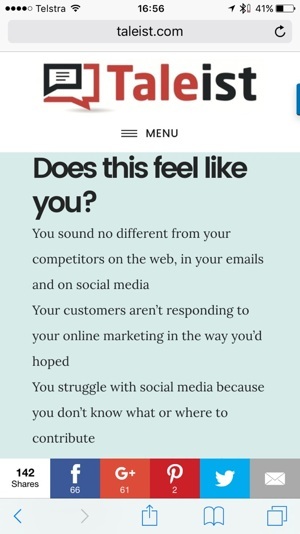 A “responsive” site looks different on a small screen so it’s easier to use. Google punishes non-responsive sites by keeping them out of results shown to people searching on mobile phones.
A “responsive” site looks different on a small screen so it’s easier to use. Google punishes non-responsive sites by keeping them out of results shown to people searching on mobile phones.5. You’re losing a heap of traffic if your site isn’t mobile-ready
Google will not show your website to people searching on their mobile phones if your website is not mobile responsive.
That could be more than half of your potential visitors. (A website that’s mobile responsive is one that adapts itself to a small screen so the user isn’t pinching, zooming or squinting.)
6. Google cares about things you probably haven’t imagined
That includes:
Spelling and grammar—yes, really. Google reasons that people who take their time over their writing are probably giving their visitors a better experience.
How fast your site opens. (Which is a better experience for the Google customer: a site that bursts open or one that oozes in like treacle?)
The quality of the coding on your site
Whether your site is easy to navigate (yes, Google can tell)
7. Google knows things that will blow your mind
Take all the information produced by the software Google has given the world, put it all in one place and you’ve given Google a mind blowing amount of information. Some of it is about you personally and all of it tells Google something about us statistically.
When it comes to how people use your website and what they think of it, Google can draw on information it gets from how they react to you in the search engine. And it can go even deeper if your visitor is using Google’s Chrome web browser or you’ve installed Google Analytics, Google Adwords or a Google remarketing pixel.
Here’s just a handful of things Google might know about your website, e.g.:
How long someone spends on your site. (If Google sends a searcher to a site and they bounce back in five seconds, Google knows the site probably wasn’t much use. It might also get that information from Google Analytics or Chrome)
Which pages on your site are the most popular
Whether people buy things on your site
Whether people email or call you
How your site shapes up to the competition
Whether the writing on your site is original
And it’s using all that to make decisions about where to put you in the search results.
Here’s the good news
You’re running an honest business where you want to give people a product or service that’s worth their money. You want them to have a good experience and you’re genuinely trying to help them.
That means Google wants to help you. Everything Google does is about connecting searchers with good information and great businesses. If that’s you, your goals and Google’s are aligned.
Keep in mind the seven points above and you’ll be a long way down the road to Google helping your business grow.
 Your website review comes with more than 20 pages of actionable tips and insights from our professional analysis of your site
Your website review comes with more than 20 pages of actionable tips and insights from our professional analysis of your siteIf you think your website might not be doing the job you need it to do, get your website professionally reviewed by us
When a single lost customer costs more than a professional website review to fix your website, what are you waiting for?
Have your website reviewed by a professional to identify strengths, weaknesses and areas for improvement. Use those insights to turn a lazy website into a sales tool that grows your business and increases your profits.
The post 7 things you must know about Google if you want it to send customers to your site (and some things Google knows that will blow your mind) appeared first on Taleist.
July 25, 2016
Are you efficiently losing sales?
This week I contacted a few agencies to help me with a family project. I sent an email describing our situation and asking two questions:
How would you work with us on this?
Roughly what would it cost
All up, my email was about 60 words.
The first agency to write back copied and pasted about 500 words from somewhere else and made that their email. I know it was copied and pasted because my name at the top and their sign off were in a different colour and font from the body of the email.
They also attached three documents.
In total, there were about 2,000 words to read. That’s between six and 10 minutes of reading. Some of it answered the question about cost; the rest was irrelevant.
Very efficient for them. A waste of time for me.
Contrast that with the second agency to reply, which sent a welcoming email suggesting we talk through it on the phone.
The seductive call of efficiency
I work in a service business too, so I know all about tyre kickers. I can see how attractive it must be to reply to every initial enquiry with a random assortment of boilerplate and file attachments. Kapow! That’ll sort the wheat from the chaff. Those who are serious will write back afterwards.
But what if they won’t?
What if your competitors have done better?
How to get more sales by being less efficient
Periodically I’m tempted by technology that promises the sort of efficiency the first agency was aiming for. Gmail, for instance, offers “canned responses”: certain keywords trigger an automatic response. There are many scenarios in my business where I’m tempted to use them, but I realise how many great clients I’d have missed if I’d asked Google to guess their value from a first email.
Here’s what I try to remember
Treat every enquiry like it might result in a sale and a referral
After drafting a reply check:
Have you answered all the questions?
Are you being consistent with your brand promise? (If you talk about being helpful and friendly, have you been?)
Have you put yourself in the customer’s shoes? This might be everyday for you, but it might not be for them. If your customers are often confused, scared or frustrated, bear that in mind when you’re writing to them.
Is your spelling and formatting in order? Some of us care.
Is the quantity of your reply consistent with the question? To me, 2,000 words spread across an email and three file attachments was out of proportion with my initial enquiry in this case.
If you’re using boilerplate, have you adapted it appropriately to the customer and the specific enquiry?
I’m not saying I get it right every time, but this is my aim.
The enquiry stage is your first impression. This is where business can be won or lost. With careful attention to your messaging, you could get a lot more sales
The post Are you efficiently losing sales? appeared first on Taleist.
July 20, 2016
This one copywriting tip will make your writing 10x more convincing
This is the first of our six free copywriting tips. Use it and you’ll see an immediate difference in your copywriting.
http://taleist.com/wp-content/uploads/2016/07/tws1show.mp4
Discover the secrets professional copywriters use to make sales
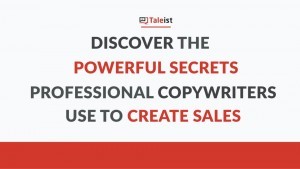 Our popular six-tip series to make your writing more persuasive
Our popular six-tip series to make your writing more persuasiveIf you want to make your own writing more convincing, get all six copywriting secrets free:
Six information-packed videos just like this one that you can act on immediately
Slide pack
Exercises you can use to make your writing more persuasive instantly
Enter your email address for immediate access
Other posts about copywriting
Some other posts with writing tips you might appreciate include:
A tale of two wine-drinking copywriters, about two completely different approaches to writing about wine
A tip about wasting words, which is what you do when you say something that’s obvious because you’d never say the opposite
Transcript
1. Show, don’t tell
The first tip is show, don’t tell. I can’t overestimate how important this is. Telling is easy. I can tell you anything. I can tell you I’m a lawyer, I’m a doctor, I’m an expert architect. It’s much harder for me to show you that I’m good at those things. For instance, if I tell you that I’m good at football, I might not be able to show you that I’m good at football.
If you’ve got a way to show your potential customers that you’re good at something don’t parse up the opportunity to do that in favor of just lightly telling them something because it has a really good chance that it would just woofed right over them, because it sounds nice but they’ve heard it all before.
Here is a good example from a client of mine, I’ve changed their name here. They’re not really cool sparky electrical, but they are electricians and they did describe themselves as a leading electrical company specializing in blah-blah.
I said to them, “Who have you worked for?” The answer was that they had some really good clients, Madame Tussauds, Macquarie Bank and Ramsay Health Care being just three of them.
Instead of saying that they were a leading electrical company, we showed their potential customers that they were a leading company by using the brands of the companies that they’ve worked for. Ramsay Health Care operates hospitals. You have to assume that they’re going to go out and find themselves a really good electrician because the consequences of having an electrical malfunction in a hospital are enormous.
By telling you, yes, I’m telling you that Ramsay Health Care is a client of mine, but I’m showing you that I’m leading. If you were to Google electrical contract, there’s you’ll probably find that half a dozen of them are more in your area described themselves as leading. It becomes meaningless. As the potential customer you’re like, “Yeah, yeah, yeah, you’re leading but what have you got that actually mean something to me?”
Another example of showing, not telling is here on Gary Vaynerchuk’s page. Gary Vaynerchuk is a New York Times bestselling author. He’s a big name in the world of online marketing.
He’s got some information on his site that tells you that he’s a big name in online marketing. But the bit that I’m interested here on the page is where he’s showing you that he’s a credible expert. He’s showing you that he’s a credible expert by telling you, yes, telling, showing, telling you all the people, all the new sources that have relied on him for a source of expert comment.
If you’ve spoken to the New York Times, Forbes, Fortune, Entrepreneur, Forest Company, Mashable, Wall Street Journal, and all of those, chances are you know what you’re talking about. He is showing you that he knows what he’s talking about.
The post This one copywriting tip will make your writing 10x more convincing appeared first on Taleist.
July 12, 2016
How to write more in less time
If you spend as much time at your keyboard as I do, you want that time to be productive. Even saving small amounts of time on repetitive typing (or typos) adds up over the course of the hours and weeks at the keyboard.
My suggestion? The humble text expander.
There are lots of them out there. I use Keyboard Maestro. On a PC, you might want to try Phrase Expander.
What does a text expander do?
Text expanders do what they say on the tin: you type a small piece of text (either a phrase or a keyboard shortcut) and they turn it into a longer piece of text.
I’ve configured mine, to do this:
Turn “bbr” into “Best regards, Steven” and “cch” into “Cheers, Steven”
Typing “bksp” turns into “http://taleist.com”. Another combination of letters takes me to the admin section of my site.
Catch typos like “teh” for “the” and correct them automatically
But that doesn’t sound like very much
I’ve seen people look at me like I’m mad when telling them I’ve bothered to configure software to do such seemingly small tasks. But I type my website address a couple of dozen times a day.
I write email after email in the day. I know some people put their sign off in their email signature–my wife sends me “Kind regards” all the time–but I prefer to tailor the sign off to the person, so I have a shortcut for “best regards” and another for “cheers”.
Time is saved in tiny increments
We’re always looking for a way to save an hour a day. That doesn’t work out well for me; how’s it working out for you?
You probably don’t have a big, juicy hour of wasted time in the day waiting to be cut. Personally, I make my savings in small ways, and it adds up.
Give a text expander a week and tell me you don’t love it. (But you have to take the time to configure it. No cheating.)
Text expander reviews
I use Keyboard Maestro and I have Alfred do some things for me, too. If you’re on a PC or you want to try something else, some good review posts I found are:
Text expander apps to try — from Zapier
10 Text Expanders To Boost Your Typing & Texting Speed — by Dejan Savanovic
The post How to write more in less time appeared first on Taleist.
June 17, 2016
Are your corporate customers stupid? These academics think so
If your customers work at big corporates, two academics have an insight for you: your customers are probably functionally stupid.
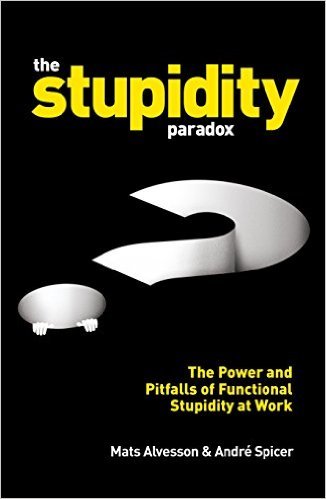 Your corporate customers might be “functionally stupid”
Your corporate customers might be “functionally stupid”Mats Alvesson and Andre Spicer, two professors of business, make that assertion in their book, The Stupidity Paradox, which the AFR Weekend has extracted.
Employees in big organisations stop questioning “showy ideas” to rub along better with their colleagues, say Alvesson and Spicer.
They call it “functional stupidity”.
What is functional stupidity?
“Functional stupidity is the inclination to reduce one’s scope of thinking and focus only on the narrow, technical aspects of the job. You do the job correctly but without reflecting on purpose or the wider context…
You sidestep the burdens of having to think too much and upsetting others by asking difficult questions.
Having had a few experiences in corporate life of being treated like an eccentric (at best) for asking why, I enjoyed the article indecently.
Why marketers should care about functional stupidity
It strikes me that marketers should be very interested in functional stupidity.
Alvesson and Spicer have piled up examples of crucial decisions being made based on a handful of PowerPoint slides. They have cases from government, business, education, IT, the military and engineering.
If that’s all the exploration your corporate customers are willing to do; you’re swimming upstream if you can’t reduce who you are, what you’re selling, and why they should buy it into the briefest possible argument.
“Companies,” say the authors of the Stupidity Paradox, “routinely talk about their brand as what makes them different, but if you take a careful look, it seems to be the same as their competitors.”
The opportunity for marketers
So the opportunity is that your customers are confused. All your competitors sound the same. You could catch their attention by sounding different.
So the opportunity is that your customers are confused. All your competitors sound the same. You could catch their attention by sounding different.
The challenge for their copywriters
The challenge is that you’ve got three bullet points to explain your difference and your value.
Go!
The post Are your corporate customers stupid? These academics think so appeared first on Taleist.
June 14, 2016
A tale of two wine-drinking copywriters
Last week I was shopping for wine and had to pull a bottle of Leaning Cow shiraz off the shelf. The askew label on the front made it irresistible; it was the copywriting on the equally atilt label on the back that made me buy it.
Compare the charming story on the back of the bottle of Leaning Cow with the revolting tasting notes for another shiraz. Which do you prefer?
 The story that charmed me into buying. (Click for a larger version)
The story that charmed me into buying. (Click for a larger version)Leaning Cow is $18 on Coe & Co’s website. A bottle of Torbreck RunRig Shiraz 2004 will set you back $239.99 at Dan Murphy’s. But check out these tasting notes someone sent me:
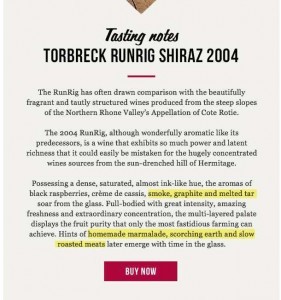 Highlighting added by us. (Click for a bigger version.)
Highlighting added by us. (Click for a bigger version.)I’m told this is a great wine, but I can’t say I fancy a mouthful of smoke, graphite and melted tar. But I’m mightily impressed that someone could pick out above the tar, the smoke, the graphite, the scorching earth and the slow-roasted meats that the hint of marmalade is of the homemade variety, not the shop-bought stuff.
The copywriting on Leaning Cow’s label concentrates on the poetic but irrelevant at the expense of information about the wine. Torbreck’s tasting notes are all about the wine but seem to lose all sight of what the ordinary person might think tastes nice. (Although maybe you’re not all that ordinary if you’re dropping $240 on a bottle of red.)
They’re two contrasting copywriting approaches: heavy on story, light on info or the reverse. Which approach works for you? And have you thought about whether you’re using the right one in your business?
The post A tale of two wine-drinking copywriters appeared first on Taleist.



